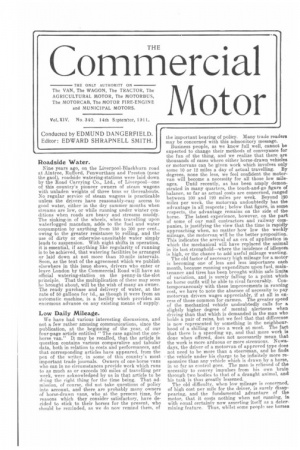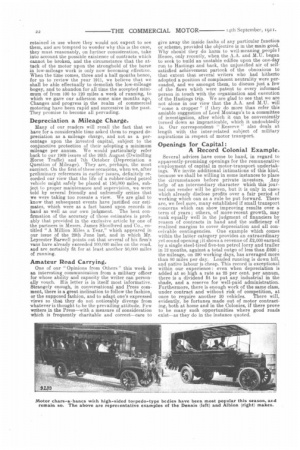Roadside Water.
Page 1

Page 2

If you've noticed an error in this article please click here to report it so we can fix it.
Nine years ago, on the Liverpool-Blackburn road at Aintree, Rufford, Penwortham and Preston (near the gaol), roadside watering-stations were laid down by the Road Carrying Co., Ltd., of Liverpool—one of this country's pioneer owners of steam wagons with unladen weights of three tons or thereabouts. No regular service of steam wagons is practicable unless the drivers have reasonably-easy access to good water, either in the dry summer months when streams are low, or while running under winter conditions when roads are heavy and streams muddy. The sinking-in of the wheels, when travelling upon waterlogged macadam, adds to the fuel and water consumption by anything from 150 to 300 per cent., owing to the greater resistance to rolling, and the use of dirty or otherwise-unsuitable water simply leads to suspension. With night shifts in operation, it is essential, if anything like regularity of running is to be achieved, that watering facilities be arranged or laid down at not more than 10-mile intervals. Soon, as the text of the agreement which we publish elsewhere in this issue shows, drivers who enter or leave London by the Commercial Road will have an official watering-station on the penny-in-the-slot principle. That the multiplication of these may soon be brought about, will be the wish of many an owner. The ready purchase and delivery of water, at the rate of 50 gallons for Id., as though it were from an automatic machine, is a facility which provides an enormous advance on any existing means of supply.
Low Daily Mileage.
We have had various interesting discussions, and not a few rather amusing communications, since the publication at the beginning of the year, of our four-page article entitled " The case against the onehorse van," It may be recalled, that the article in question contains various comparative and tabular data, both in relation to costs and performances, and that corresponding articles have appeared, from the pen of the writer, in some of this country's most important trade journals. Owners of one-horse vans who can in no circumstances provide work which runs to as much as or exceeds 100 miles of travelling per week, were acknowledged by us in that article to be doing the right thing for the time being. That admission, of course, did not take questions of policy into account, and there are probably many owners of horse-drawn vans, who at the present time, for reasons which they consider satisfactory, have decided to stick to their horses for the present, who should be reminded, as we do now remind them, of the important bearing of policy. Many trade readers may be concerned with this admonitory message. Business people, as we know full well, cannot be
expected to change their methods of conveyance for the fun of the thing, and we realize that there are thousands of cases where either horse-drawn vehicles or motorvans can be given work which involves only some 10 or 12 miles a day of actual travelling. By degrees, none the less, we feel confident the motorvan will become a necessity for all those low mileages. Until recently, as has been amply demonstrated in many quarters, the touch-and-go figure of balance, so far as actual costs are concerned, ranged between 100 and 120 miles per week. Beyond 120' miles per week, the motorvan undoubtedly has the advantage in all respects ; below that figure, in some respects, the advantage remains on the side of the horse. The latest experience, however, on the part of some of our mail contractors and railway companies, is justifying the view that the time is rapidly approaching when, no matter how low the weekly mileage, the motorvan will be the better proposition. This indicates the arrival of an era of application in which the mechanical will have replaced the anima/ in its last, stronghold—where the incidence of idlenexa is high, or the chance to add useful mileage wanting. The old factor of necessary high mileage for a motor is becoming one of .less and less importance each month, because running expenditure upon fuel, maintenance and tires has been brought within safe 'mite of variation, and is surely falling to a point which no horse outfit will be able to rival favourably. Contemporaneously with these improvements in running cost, we have to note the absence of necessity to pay motorvan drivers wages appreciably, if at all in excess of those common for carmen. The greater speed of the mechanical vehicle undoubtedly calls for a slightly higher degree of mental alertness when driving than that which is demanded in the man who holds a pair of reins, but we feel that that difference is now represented by something in the neighbourhood of a shilling or two a week at most. The fast that there is a speeding up, and that more work is done when offered, does not necessarily mean that the work is more arduous or more strenuous. Nowadays, the driver of a motorvan of approved type does not need to be more than a steersman, and he finds
• the vehicle under his charge to be infinitely more responsive than any vehicle which is drawn by a horse, in so far as control goes. The man is relieved of the necessity to convey impulses from his own brain through two bodies to that of a draught animal, and his task is thus greatly lessened.
The old difficulty, when low mileage is concerned, of high cost ner mile for the driver, is surely disappearing, and the fundamental advantage of the motor, that it costs nothing when not running, la with equal certainty now asserting itself as a determining feature. Thus, whilst some people see horses
retained in use where they would not expect to see them, and are tempted to wonder why this is the case, they must reasonably, on further consideration, take into account the possible existence of contracts which cannot be broken, and the circumstance that the attack of the motor upon the stronghold of the horse in low-mileage work is only now becoming effective. When the time comes, three and a half months hence, for us to review the year 1911, we believe that we shall be able effectually to demolish the low-mileage bogey, and to abandon for all time the accepted minimum of from 100 to 120 miles a week of running, to which we gave our adhesion some nine months ago. Changes and progress in the realm of commercial motoring have been rapid and successive in the past. They promise to become all pervading.
Depreciation a Mileage Charge.
Many of our readers will recall the fact that we have for a considerable time asked them to regard depreciation as a mileage charge, and not as a percentage upon the invested capital, subject to the conjunctive protection of their adopting a minimum mileage per annum. We would particularly refer back to our 1909 issues of the 26th August (Dwindling Horse Traffic) and 7th October (Depreciation a Question of Mileage). They are,, perhaps, the most succinct. On the first of these occasions, when we, after preliminary references in earlier issues, definitely recorded our view that the life of a rubber-tired petrol vehicle might safely be placed at 150,000 miles, subject to proper maintenance and supervision, we were told by several friendly and unfriendly critics that we were taking too roseate a view. We are glad to know that subsequent events have justified our estimates, which were as a fact based upon records in hand as well as our own judgment. The best confirmation of the accuracy of those estimates is probably that provided in the exclusive article by one of the partners in Messrs. James Shoolbred and Co. entitled "A Million Miles a Year," which appeared in our issue of the 29th June last, and in which Mr. Leyeester Barwell points out that several of his firm's vans have already exceeded 100,000 miles on the road, and are certainly fit for at least another 50,000 miles of running.
Amateur Road Carrying.
One of our "Opinions from Others" this week is an interesting communication from a military officer for whose ability and capacity the writer can personally vouch. His letter is in itself most informative. Strangely enough, in conversational and Press comment, there is a great inclination to follow the fashion, or the supposed fashion, and to adapt one's expressed views so that they do not noticeably diverge from whatever is thought to be the prevailing attitude. Few writers in the Press—with a measure of consideration -which is frequently charitable and correct—care to
give away the inside faults of any particular function or scheme, provided the objective is in the main good. Why should they do harm to well-meaning people I Hence, only recently, when the A.A. and M.U. began to seek to build an unstable edifice upon the one-day run to Hastings and back, the unjustified air of selfsatisfied achievement partook of the obnoxious to that extent that several writers who had hitherto adopted a position of complacent neutrality were persuaded, and we amongst them, to discuss just a few of the flaws which were patent to every informed person in touch with the organization and execution of the Hastings trip. We are glad to see that we are not alone in our view that the A.A. and M.U. will "come a cropper" if they do more than refer this amiable suggestion of Lord Montagu's to a committee of investigation, after which it can be conveniently turned down as impracticable, which it undoubtedly is. Our correspondent "Reserve " also deals at length with the inter-related subject of military aspirations in respect of motor transport.
Openings for Capital: A Record Colonial Example.
Several advices have come to hand, in regard to apparently-promising openings for the remunerative employment of capital in motor-transport undertakings. We invite additional intimations of this kind, because we shall be willing in some instances to place the circumstances before private investors. Any help of an intermediary character which this journal can render will be given, but it is only in cases which already disclose profits over a fair period of working which can as a rule be put forward. There are, we feel sure, many established if small transport concerns which can show improving results over a term of years ; others, of more-recent growth, may rank equally well in the judgment of financiers by reason of contracts in hand and the sufficiency of realized margins to cover depreciation and all conceivable contingencies. One example which comes within the latter category provides an extraordinary yet sound opening ; it shows a revenue of £2,000 earned by a single steel-tired five-ton petrol lorry and trailer in 12 months, against a total outgo of less than £600; the mileage, on 290 working days, has averaged more than 80 miles per day. Loaded running is down hill, and native labour is cheap. This record is exceptional within our experience : even when depreciation is added at so high a rate as 25 per cent. per annum, there is a dividend fit to put any industrial in the shade, and a reserve for well-paid administration. Furthermore, there is enough work of the same class, under contract and without risk of competition, at once to require another 20 vehicles. There will, evidently, be fortunes made out of motor contracting, both at home and in the Colonies, if there prove to be many such opportunities where good roads exist—as they do in the instance quoted.




















